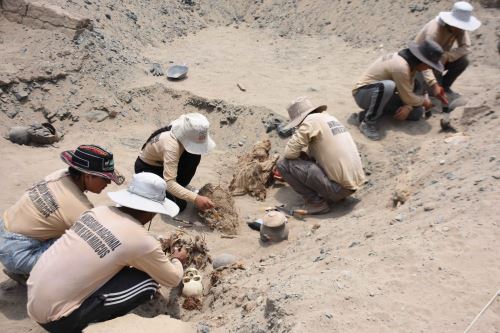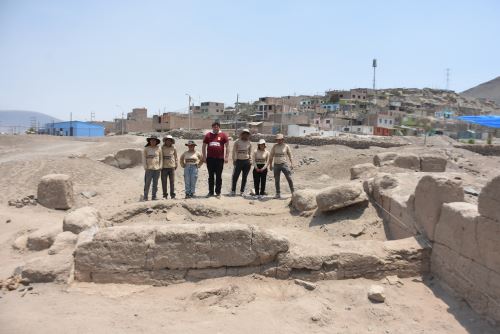12:32 | Huaral (Lima region), Feb. 10.
Researchers from the
Universidad Nacional Mayor de San Marcos (National University of San Marcos) made an important archaeological discovery by finding human remains from more than 800 years ago at the Macaton Funerary Archaeological Site in Huaral province, Lima region.
After stating that
the archaeological finding was in charge of a team of specialists led by archaeologist Pieter van Dalen, the
UNMSM specified that these are the
remains of two adult individuals and one neonate, who belonged to the Chancay Culture, from the late intermediate period (1000 -1550 AD).
It affirmed that the child and one of the adults are inside funeral bundles or textile wrappings —still unopened.
According to the researchers, they would be a mother and her son. The other adult individual was found in a skeletal state with their bundles torn by huaqueros (tomb looters).

The researchers explained that each individual is associated with a group of ceramics and vessels, inside which are food remains, such as corn, fruits, pacay leaves, cotton seeds, guinea pigs, etc., which were placed as part of the funeral ritual.
Pieter van Dalen revealed that it would be a multiple burial, which occurred during 1200 AD or later, and the deceased would have belonged to a low social stratum of the Chancay Culture.
Death was a very important process for Chancay society.
Funeral rituals were performed that lasted several days. Among funeral songs and dances, the deceased was placed inside textile wrappings or bundles, and around them funeral offerings inside vessel —also sacrificed llamas or guinea pigs, labor instruments of the deceased, among other personal and family belongings.
Death —he added— also had a mystical and magical-religious connotation.
"After the burial, from time to time, ceremonies were held in honor of the ancestor. Some deceased, who had excelled in their Ayllu, became Mallquis or powerful ancestors, protectors of their family and society, being the object of multiple rituals and offerings," he explained.
Macaton is one of the most important and extensive cemeteries of the Chancay Culture, located in the lower Chancay Valley, five kilometers south of the city of Huaral, in the town of El Angel —an hour and a half by car from Downtown Lima.
It is a site that has been constantly studied since 2018 with funding from the Office of the Vice-Rector for Research and Postgraduate Studies at the
UNMSM.
As part of this study, numerous funerary contexts have been found placed inside quadrangular tombs up to more than three (3) meters deep, which contained the remains of various people placed at different times. The researchers think that these would be members of each family, buried during a long time.

Chancay Culture
The Chancay Culture developed in the north-central Peruvian coast (between Ancon to the south and the Supe valley to the north) in the late pre-Hispanic periods (1000-1550 AD).
It consisted of a first period of independent life (1000-1470 AD), then another of Inca domination (1470-1533 AD), followed finally by the stage under Spanish domination (1533-1551 AD).
The large settlements of this culture, with mud buildings, are located in the corners of the valley. There were also large cemeteries that feature funerary architecture, such as those of Macaton, Lauri, Tronconal, and Pasamayo, among others.
(END) NDP/MAO/MVB
Published: 2/10/2023